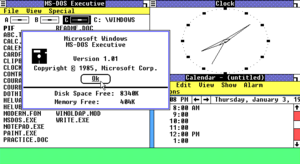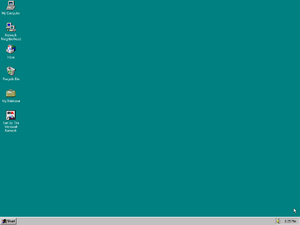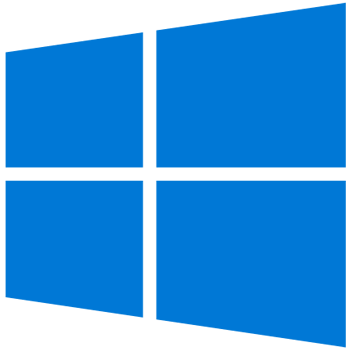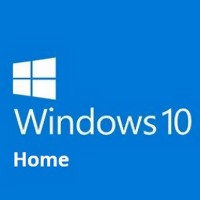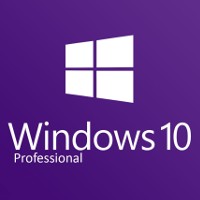Microsoft Windows
Microsoft Windows is a desktop operating system developed by Microsoft since 1983. The latest released version as of April 2021 is Windows 10 October 2020 Update.
The first versions of Windows were an operating environment and graphical shell for MS-DOS. Windows 95 and later used MS-DOS for booting and kernel initialization. NT-based versions of Windows use a redesigned kernel and do not rely on MS-DOS.
Contents
History
16-bit Windows
Microsoft Windows debuted to the world during the Fall COMDEX 1983 computer expo as an operating environment running on top MS-DOS. The final version of the product with the version number of 1.01 was later released on 20 November 1985 and did not gain much popularity. Windows 1.0 was a cooperative multitasking desktop environment with a tiling window manager. The first versions of Windows used the MS-DOS Executive, which was a simple file manager, as a shell, which is generally the first application ran on startup providing the user experience. Other applications included in the first version of Windows included Calculator, Cardfile, Clipboard Viewer, Clock, Control Panel, Notepad, Paint, Reversi, Spooler, Terminal, and Write. Three minor updates were released in the two following years adding support for more hardware.
A major update called Windows 2.0 was released in 1987 adding features such as overlapping windows. This version also introduced support for the Video Graphics Array and PS/2 mouse (though the IBM OEM of Windows 1.04 includes these features). A separate edition called Windows/386 was introduced that took advantage of the virtual 8086 mode of the then-new 386 processor to multitask MS-DOS applications under Windows; this would later become known as the 386 Enhanced Mode and become the cornerstone of Windows 9x. In later revisions of the Windows 2.0 environment, the original edition was renamed Windows/286.
Windows 3.0 was released in 1990 and became the first widely successful version of Windows. The new features included a revamped user experience consisting of the Program Manager, which allowed easy management of installed applications. A new File Manager was also included to replace the former shell, which was now deprecated. Under the hood, the new Standard Mode was introduced, which took advantage of the protected mode of the 286 and 386 processors. The previously separate 286 and 386 editions of Windows were unified into one version. This version of Windows was able to operate in three modes: Real mode intended for computers with the original 8088/8086 processor, Standard mode using the protected mode feature of the 286 processor, and 386 Enhanced mode combining the improved protected mode of the 386 with its ability to create and manage virtual 8086 machines for MS-DOS applications.
A major update dubbed Windows 3.1 followed in 1992 with the brand new red-green-blue-yellow Windows logo resembling a flag. The user interface was refreshed in this release, including new colorful icons. This version of Windows removed the real mode of operation and the MS-DOS Executive application. It was accompanied with a variant called Windows for Workgroups (WfW) 3.1 with an integrated networking capability, which later received a larger update bringing its version number up to 3.11, introducing 32-bit disk access and also removing the Standard mode of operation. The regular variant of Windows also received the 3.11 update, which was essentially the kernel of Windows for Workgroups 3.11 backported to Windows 3.1.
A 32-bit TCP/IP stack was ported from an early version of Windows 95 and released in 1994 as a downloadable plugin for Windows for Workgroups 3.11, providing early testing for the 16/32-bit compatibility features of the next version of Windows.
Windows 9x
On 24 August 1995, Microsoft released Windows 95, previously known under its codename «Chicago», with a brand new user interface with a Start menu, taskbar, and the desktop, as provided by the new Windows Explorer. Its hybrid 16/32-bit architecture made it possible to make and run 32-bit Windows applications and drivers while keeping a great degree of compatibility with already existing 16-bit ones. Among other improvements in this version was the support for long filenames through an extension to the FAT16 file system.
Windows 95 was the first widespread release of Windows to be packed together with a specific MS-DOS version, however, the old operating system was used only as a bootloader and a compatibility layer for ancient device drivers. Most MS-DOS user applications were either extended with Windows code or entirely replaced with a Windows version, keeping only the ones that were required to run without Windows, e.g. during the OS installation, such as FDISK and FORMAT .
During its lifetime Windows 95 saw several larger updates dubbed the OEM Service Releases (OSR) that were released only to computer manufacturers, specifically OSR 1.0, OSR 2.0, OSR 2.1, and OSR 2.5. A Service Pack was also released that updated an RTM copy of Windows 95 to the OSR 1.0 level. In 1997 a USB Supplement was released for OSR 2.x that added support for the then-new Universal Serial Bus interface.
The classic Windows line received a major update on 25 June 1998 with the release of Windows 98, codenamed «Memphis». It was the first version to integrate Internet Explorer deeply into the operating system’s user interface as a part of the Windows Desktop Update. Many parts of the UI started using HTML and Internet Explorer’s rendering engine to present a web-like user interface. A feature called Active Desktop made it even possible to set a webpage as the desktop background. Under the hood Windows 98 introduced the new Windows Driver Model, which enabled the use of the same drivers on Windows 9x as well as on the radically different Windows NT based operating systems.
A year later, Windows 98 received an update which was called the Second Edition, which included a new version of Internet Explorer, added Internet Connection Sharing and improved USB support.
In 2000, Windows Me (Millennium Edition), the last release of the classic Windows line was released. It carried over the improvements made to the user interface in its NT-based counterpart, Windows 2000. Windows Me is based on Windows 98, however, access to the real mode MS-DOS was restricted in order to decrease boot time among other changes to the kernel. It was infamously known for its stability problems partially caused by the rushing of its release following the cancelation of the Neptune project. It was replaced by Windows XP in 2001, ending the era of classic Windows.
Windows NT
Windows NT (New Technology) is the current iteration of Windows. It is built on the NT hybrid kernel, which was originally intended for use in OS/2 3.0 but was adapted for a 32-bit version of Windows after the Microsoft — IBM split. The first release based on the new kernel was Windows NT 3.1, which was launched in 1993 and was equivalent to Windows 3.1 released two years earlier. All NT-based releases up until Windows 2000 were intended primarily for business use. With Windows XP, the NT series replaced the classic Windows series, creating a single operating system for consumers and businesses. Windows Phone 8 is the first Windows Phone release to be based on the NT kernel. The most recent version of Windows based on the NT kernel is Windows 10. Following the release of Windows 10, Microsoft has switched to a system of more frequent smaller updates to Windows.
Look and feel
Windows allowed customization of its user interface since its first versions. Windows 1.0 and Windows 2.x allowed the user to change the color scheme in their Control Panel, however, there was no selection of pre-made color schemes and the user only had the option to reset to the default scheme, which was provided by the installed video driver. This was improved with Windows 3.0 and its new Colors control panel, which added several color schemes for the user to choose from, however, the Windows default preset was still dependent on the type of the graphics card installed. Windows NT 3.1 and Windows NT 3.5x also featured the same Color control panel applet, however, drivers no longer had the ability to override the default color preset.
Windows 95 introduced a new 3D look inspired by NeXTSTEP which initially only made use of solid colors. This was subsequently refined in Windows 98 and Windows 2000 with the possibility to use 2-color gradients for the titlebar. Windows XP introduced a proper theming engine, allowing the use of bitmaps for various user interface elements and saw the first proper visual style, called Luna, come in to use, but users could still switch to Windows Classic if they so chose. Windows Vista introduced the hardware-accelerated Desktop Window Manager, which allowed for advanced effects such as translucent title bars used by the new Windows Aero theme. For users whose hardware couldn’t handle Aero, Windows Vista included the software rendered Windows Basic theme.
With Windows 8 and Windows 8.1, the Aero theme was revamped and the Aero Lite theme replaced the Basic theme for lower-end computers. In Windows 10, the Aero theme was revamped again, but the Aero Lite theme remained. Windows 10’s November Update saw the option to enable colors on title bar. Finally, with Windows 10 build 18282, the new Light theme was introduced.
Source code
In 2004, incomplete copies of the source code of Windows NT 4.0 and Windows 2000 leaked to the Internet. These leaks were illegal, as the Windows source code is both a trade secret and copyrighted, and as so is protected by law. However, Microsoft has released parts of the source of the Windows Server 2003 kernel for research purposes.
In 2017, The Register and other technology journals reported about a leak of the Windows 10 Shared Source Kits, which are available to qualified customers, enterprises, governments, and partners for debugging and reference purposes, to BetaArchive. Following the controversy, BetaArchive removed all source code content from its archives, which also included the aforementioned incomplete copies of the Windows source code, and adopted a policy of not accepting any more source code material.
In 2018, the source code of the Windows NT File Manager ( winfile ) was released on GitHub under the open source MIT license. This was later followed in 2019 by the Windows 10 Calculator application.
In May 2020, a copy of the source code of Windows NT 3.5 build 782.1 leaked to the 4chan /vp/ board. It is not yet known whether the leaked source is complete. This was later followed in September by the source code of Windows XP Service Pack 1 and Windows Server 2003. The leaked copy is mostly complete, but misses activation components, therefore it is likely that the leak originated from a Microsoft partner who had access to the source code rather than Microsoft itself. This code base had been apparently circulating in online circles since at least 2015.
Windows
Windows may refer to any of the following:
1. Microsoft Windows (also referred to as Windows or Win) is a graphical operating system developed and published by Microsoft. It provides a way to store files, run software, play games, watch videos, and connect to the Internet.
Microsoft Windows was first introduced with version 1.0 on November 10, 1983. Over a dozen versions of Windows were released after that, including the current version, Windows 10.
Editions of Windows
Starting with Windows XP, Microsoft has published various editions of Windows. Each of these Windows editions has the same core operating system, but some editions have additional features, at an additional cost.
The two most common editions of Windows for home computers are Windows Home and Windows Professional.
Windows Home
Windows Home (also called Win Home) is the basic edition of Windows. It provides all the fundamental functions of Windows, such as connecting to the Internet, browsing the web, watching videos, using office software, and playing video games. It is the least expensive edition of Windows, and it comes preinstalled on many new computers.
Windows Pro
Windows Professional (also called Windows Pro, or Win Pro) is an enhanced Windows edition, for power users, and small to medium sized businesses. It includes all the features of Windows Home, plus the following:
- Remote Desktop — allows you to remotely control another Windows computer connected to the Internet.
- Bitlocker — Microsoft’s integrated file encryption.
- Trusted Boot — provides encryption of the boot loader, protecting the computer against rootkits.
- Hyper-V — a Windows hypervisor for running virtual machines, equivalent to third-party software, such as VirtualBox.
- Windows Sandbox — provides a lightweight, sandboxed Windows 10 instance. You can use this isolated «Windows within Windows» environment to safely run suspicious or untrusted software. Windows Sandbox requires a Windows Insider build of Windows 10 Pro or Enterprise.
- Group policy management — Administrators can define group policies, for managing multiple Windows users in a business or organization.
- Support for more than 128 GB of RAM.
- Greater Windows Update installation options, including more flexible scheduling and postponement for up to 35 days.
Business editions
Windows Professional for Workstations and Windows Enterprise provide advanced features for professional studios and large businesses. For more information, refer to the side-by-side comparison in the official Microsoft Windows business edition comparison chart.
Why is Microsoft Windows called Windows?
Before the release of Microsoft Windows, Microsoft users were used to the single task command line operating system MS-DOS. Because Microsoft names most of its products with one word, it needed a word that best described its new GUI operating system. Microsoft chose «Windows» because of the multiple windows that allow different tasks and programs to run at the same time. Because you cannot trademark a common name like «Windows,» it’s officially known as «Microsoft Windows». The first version of Microsoft Windows was version 1.0, released in 1985.
Microsoft Windows help pages
Related pages
2. In general, a window is a fundamental part of a computer GUI (graphical user interface). A window is an area of the display containing a single running application. The window can be moved, resized, hidden, or maximized as desired by the user. The Microsoft Windows operating system is named after this UI element.
3. Regarding Unix-like operating systems, such as Linux or BSD, Windows may refer to the X Window System.
